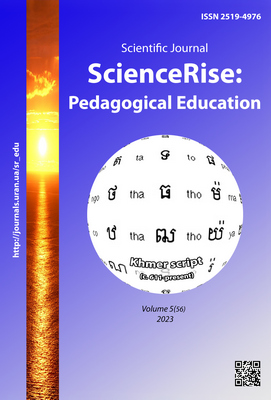The significance of calligraphy training for the future teacher in the context of art and graphic competence
DOI:
https://doi.org/10.15587/2519-4984.2023.293617Keywords:
calligraphy, future teacher, teacher training, competence, artistic and graphic activity, font, compositionAbstract
The article examines the problems of calligraphy training in the context of artistic and graphic competence during the training of future teachers. The main problems related to the insufficient preparation of the teacher for the formation of artistic and graphic skills are identified, namely the absence or a small number of hours, devoted to the study of such educational components as «Calligraphy», «Drawing», «Art graphics», lack of explanatory work from the scientific and pedagogical staff of higher education institutions about the importance of artistic and graphic skills. A characterization of the components of the artistic and graphic training of future teachers was carried out, in which the mastering of calligraphy skills by students was identified as a key aspect. The components of calligraphy training are characterized, including mastering the basics of fonts, developing the muscles of the arm and hand, learning the correct posture of the arm and body, using various materials for writing, training hand motility, learning the elements of calligraphy, creating and analyzing calligraphy samples.
The article examines the font as the basic unit of calligraphy and font composition as the art of creating harmonious and aesthetically balanced layouts using different fonts. The main methodical components of the study of fonts are outlined and some methodical techniques are proposed for teaching future teachers the basics of creating a font composition. As a result, the value of calligraphy training of future teachers for their professional activities was determined, in particular, improving the quality of teaching writing for 1st grade students, ensuring the writing culture of students, developing and supporting the speaking skills of education seekers, ensuring a creative approach, increasing the general aesthetic level of the personality of the future teacher, diversification of methods of working with students in classroom and extracurricular activities
References
- Gordon, J., Halasz, G., Krawczyk, M., Lener, T., Michel, A. et al. (2009). Key competences in Europe: opening doors for lifelong learner. Case Network Reports No. 87, 328.
- Berladyn, O. A., Berladyn, O. B. (2012). Actualization of future teachers training to teach calligraphic writing in primary school for Ukrainian and English languages. Naukovyi visnyk Volynskoho natsionalnoho universytetu imeni Lesi Ukrainky. Rozdil V. Innovatsiino-intehratyvnyi pidkhid u navchanni, 14, 142–146.
- Tsepova, I. V. (2015). Metody i pryiomy navchannia pysma: istoriia i suchasnist. Naukovyi ohliad, 8 (18). 1–11. Available at: http://oaji.net/articles/2015/797-1445617539.pdf
- Pryshchepa, O. Yu. (2012). Navchannia pysma v 1 klasi. Kyiv: Osvita, 192.
- Peng, M., Zhang, H. (2022). New Challenges and Countermeasures of Calligraphy Education in Colleges and Universities in the New Era. Creative Education, 13 (8), 2544–2552. doi: https://doi.org/10.4236/ce.2022.138161
- Zhang, H., Peng, M. (2022). On the Value Orientation of Calligraphy Education in Colleges and Universities in Multimedia Era. Creative Education, 13 (9), 2745–2753. doi: https://doi.org/10.4236/ce.2022.139173
- Qiu, M., Perey, G. M. (2021). Research on the necessity of teaching traditional calligraphy in primary schools. Frontiers in Educational Research, 4 (15). doi: https://doi.org/10.25236/fer.2021.041502
- Karpenko, N.A. (2016). Psykholohiia tvorchosti. Lviv: LvDUVS, 155.
- Shpak, O. (2023). Sutnist poniattia «kalihrafiia»: teoretychnyi dyskurs. Society and Science Interconnection: scientific sollection proceedings of the 2nd International scientific and practical conference. Portugal, 153, 177–182.
- Zelisko, L. Kalihrafiia ta mystetstvo. Available at: https://gallery101.com.ua/calligraphy-and-art/ Last accessed: 01.12.2023
- Chuprykov, A. P., Hnatiuk, R. M., Chuprykova, M. A. (2011). Asymetriia mozku ta livorukist. Kyiv: KMM, 140.
- Mitchenko, V. S. (2018). Kalihrafiia. Vzaiemovplyvy shryftiv: teoriia i praktyka; kyrylytsia i latynytsia; istoriia i suchasnist. Kyiv: Laurus, 288.
- Snarskyi, O. V. (1975). Shryft v mystetstvi khudozhnoho oformlennia. Kyiv, 16.
- Kolektsii shryftiv Rentafont. Available at: https://rentafont.com.ua/font_collections Last accessed: 10.11.2023
- Tereschenko, A. A., Chernyavsky, K. V. (2016). The impact of digital progress on classical calligraphy. Limbo lettering as a tool of modern design, 2 (19), 1–7.
- Borysov, V. (2021). Font composition as a playground for graphic experiments. Humanities Science Current Issues, 1 (37), 21–26. doi: https://doi.org/10.24919/2308-4863/37-1-4
- Mala, T. V. (2010). Holovni vymohy do roboty nad zavdanniamy zi shryftovymy kompozytsiiamy z dystsypliny «Shryft» maibutnikh fakhivtsiv z hrafichnoho dyzainu u VNZ. Visnyk Luhanskoho natsionalnoho universytetu imeni Tarasa Shevchenka. Pedahohichni nauky, 6 (193 (1)), 162–167.
Downloads
Published
How to Cite
Issue
Section
License
Copyright (c) 2023 Tetyana Ageyenko, Kateryna Korsikova, Svitlana Nikulenko

This work is licensed under a Creative Commons Attribution 4.0 International License.
Our journal abides by the Creative Commons CC BY copyright rights and permissions for open access journals.
Authors, who are published in this journal, agree to the following conditions:
1. The authors reserve the right to authorship of the work and pass the first publication right of this work to the journal under the terms of a Creative Commons CC BY, which allows others to freely distribute the published research with the obligatory reference to the authors of the original work and the first publication of the work in this journal.
2. The authors have the right to conclude separate supplement agreements that relate to non-exclusive work distribution in the form in which it has been published by the journal (for example, to upload the work to the online storage of the journal or publish it as part of a monograph), provided that the reference to the first publication of the work in this journal is included.








